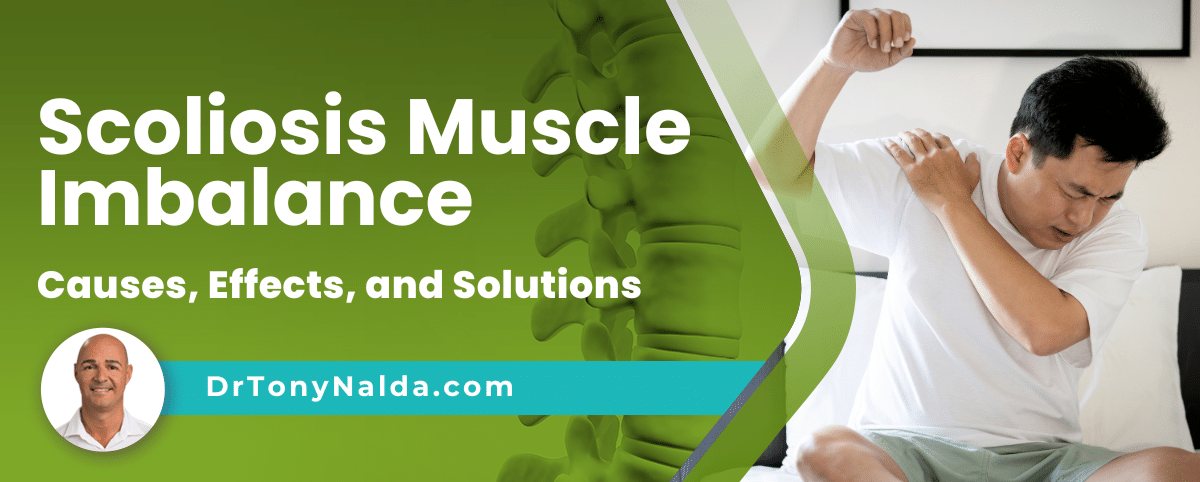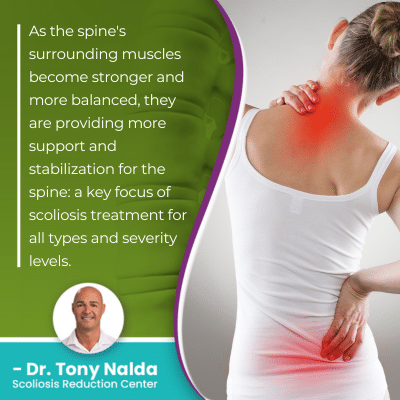Scoliosis Muscle Imbalance: Causes, Effects, and Solutions

When it comes to the muscles on one side of the spine being stronger than muscles on the other side, this can cause stiff and sore muscles for overuse and weak muscles from underuse. Painful muscle spasms can develop, and treatment involves addressing any muscle imbalance.
Scoliosis is a structural spinal condition, but it doesn't just affect the spine, but also its surrounding nerves and muscles. A muscle imbalance can develop as the unnaturally-curved and rotating spine is pulling its surrounding muscles in different directions.
As the effects of scoliosis can range widely, let's start with what causes a muscle imbalance, and then explore some other common symptoms of scoliosis.
Table of Contents
Scoliosis Muscle Imbalance
If the bones of the spine (vertebrae) are aligned in a straight and neutral position, the spine's natural and healthy curves are in place; if scoliosis causes the spine to develop an unnatural spinal curve that bends to the side and twists, the spine is misaligned.
Scoliosis introduces a lot of uneven forces to the body, and this disrupts the body's overall symmetry and causes a number of effects.
It's not just the spine that has to maintain its natural curves and alignment, but also its surrounding muscles; it's their job to stabilize and support the spine.
The large muscles of the lower back help support the spine, and these are known as the erector spinae, and along with the gluteal muscles, they maintain the spine's upright and straight position.
Flexor muscles attach to the spine at the front, and combined with the abdominal muscles, they facilitate movements such as arching the lower back, bending, lifting, and twisting.
As an unnatural spinal curve develops, its effects will increase the more severe the scoliosis gets, and as the spine's surrounding muscles develop a muscular imbalance due to the condition's uneven forces, muscle atrophy can develop.
Spinal Section and Muscle Imbalance
 There are three main spinal sections, and scoliosis can develop in any one section, or in more than one as a combined scoliosis: the cervical spine, thoracic spine, and the lumbar spine.
There are three main spinal sections, and scoliosis can develop in any one section, or in more than one as a combined scoliosis: the cervical spine, thoracic spine, and the lumbar spine.
The thoracic spine (middle/upper back) is the most common spinal section to be affected by scoliosis.
In most cases, the area of the body located the closest to the affected spinal section is going to be the most likely to experience its direct effects.
So in cases of an unnatural scoliotic lumbar curve, it's most likely to the muscles of the lower back that will become unbalanced, and this along with postural changes in the lower body can disrupt a patient's balance, coordination, and gait.
While the main effects of scoliosis will surround the affected spinal section, the condition does introduce uneven forces to the entire body, so its effects can be widespread.
There are also different types of scoliosis to consider.
Different Types of Scoliosis and Muscle Imbalance
There are also different types of scoliosis a person can develop, and type is determined by causation.
The main type of scoliosis to affect all ages is idiopathic scoliosis, which means not clearly associated with a single-known cause, and the most prevalent type of scoliosis overall is adolescent idiopathic scoliosis, diagnosed between the ages of 10 and 18.
Idiopathic scoliosis curves are considered typical and bend to the right away from the heart, but atypical curves can bend to the left, towards the heart.
Right-bending curves are going to cause the muscles on the right side of the spine are going to be working harder to attempt to counteract the spine's unnatural pull to the right, so these muscles will be getting stretched and overused; the muscles on the left side of the curve are becoming weaker and smaller from lack of use: a muscle imbalance.
Atypical types of scoliosis tend to be more severe, because they have an underlying pathology so their effects are more severe, including a scoliosis related muscular imbalance.
Approximately 80 percent of known cases are idiopathic scoliosis, and the remaining 20 percent consist of types with known causes: neuromuscular scoliosis, congenital scoliosis, and degenerative scoliosis.
Neuromuscular scoliosis cases are among the most severe because the scoliosis is caused by the presence of a larger neuromuscular condition such as cerebral palsy, muscular dystrophy, or spina bifida.
Because there is a larger neuromuscular condition causing a disconnect between the brain, the muscles, muscle tissue, and connective tissues that support the spine, muscular imbalances tend to be more severe and have specific treatment needs.
What are the other effects of scoliosis?
Scoliosis is a progressive condition, meaning its nature is to get worse over time, and this means that the size of the unnatural spinal curve is increasing, as are its effects.
So as scoliosis progresses from mild scoliosis to moderate scoliosis, severe and very severe scoliosis, the spine's surrounding muscle strength is affected, along with balance and coordination.
If a single unnatural spinal curve is present, the biomechanics of the entire spine are disrupted, and this can mean a spine that's weaker, less flexible, and less able to evenly absorb and distribute mechanical stress incurred during movement.
Changes to gait are common because if the spine is curved unnaturally, the upper body's weight isn't evenly distributed over the hips and pelvis, so an uneconomical gait can develop.
Additional effects of scoliosis can involve pain, but this is more commonly a part of adult scoliosis than childhood scoliosis; scoliosis doesn't become a compressive condition until skeletal maturity has been reached.
It's compression (uneven pressure) of the spine and its surrounding muscles and nerves that causes the majority of condition-related pain.
If scoliosis is left untreated, it's likely to continue progressing and can cause complications such as digestive issues, lung impairment, and migraines.
A muscle imbalance can be painful and cause spasms, and back pain and pain that radiates into the extremities due to nerve compression are additional symptoms of scoliosis that can get worse alongside progression.
How is a Scoliosis Muscle Imbalance Treated?
 There are never treatment guarantees, but with early detection and when treated proactively, there are fewer limits to what can be achieved with treatment.
There are never treatment guarantees, but with early detection and when treated proactively, there are fewer limits to what can be achieved with treatment.
A scoliotic curve has to be addressed primarily on a structural level because the underlying nature of scoliosis is structural, and effects such as postural deviation and a muscle imbalance are symptoms that will be addressed as their cause is treated: the condition itself.
As a scoliotic curve is reduced through chiropractic care, its effects are also improved, and physical therapy and scoliosis exercises are key facets of scoliosis treatment that focus on restoring the spine's surrounding muscle strength and symmetry.
Physical therapy and scoliosis-specific exercises can work towards strengthening the spine's surrounding muscle strength, strengthening weakened muscles, and relaxing and healing strained and overused muscles.
As scoliosis develops, the spine loses its stability and balance, and treatment has to work towards increasing the spine's support and stability, and this is where the spine's surrounding muscles are important.
As the spine's surrounding muscles become stronger and more balanced, they are providing more support and stabilization for the spine: a key focus of scoliosis treatment for all types and severity levels.
Conclusion
As the brain and spine work in tandem to form the body's central nervous system, spinal conditions can cause a wide range of symptoms felt not just in the spine.
Scoliosis doesn't just cause the spine to bend and twist, it also affects the body's posture, muscles, movement, and nerve function.
Maintaining muscle strength and symmetry is key when it comes to spinal support and stability, and as scoliosis progresses, the spine becomes increasingly unbalanced and unstable.
Maintaining good posture is important for people with scoliosis, and postural awareness and retraining is another area of conservative treatment.
Here at the Scoliosis Reduction Center, I want to treat the spine, its surroundings, and the entire body; this is how people with scoliosis improve their overall quality of life.
As a scoliotic curve develops, it's disrupting the spine's strength and function, as well as the strength and function of its surrounding muscles and nerves.
If one side of the body has a prominent lean to one side and is stronger than the other, left untreated, this will get more severe and disrupt movement increasingly over time.
In addition, for adults, back pain can also increase over time, and increasing structural support for the spine by strengthening and balancing its surrounding muscle strength can help minimize condition effects, such as a scoliosis related muscle imbalance.
In order to avoid reduced mobility and increasing postural changes and to treat scoliosis effectively, proactive treatment is needed to impact the condition on multiple levels and increase muscle strength.
Dr. Tony Nalda
DOCTOR OF CHIROPRACTIC
After receiving an undergraduate degree in psychology and his Doctorate of Chiropractic from Life University, Dr. Nalda settled in Celebration, Florida and proceeded to build one of Central Florida’s most successful chiropractic clinics.
His experience with patients suffering from scoliosis, and the confusion and frustration they faced, led him to seek a specialty in scoliosis care. In 2006 he completed his Intensive Care Certification from CLEAR Institute, a leading scoliosis educational and certification center.
About Dr. Tony Nalda
 Ready to explore scoliosis treatment? Contact Us Now
Ready to explore scoliosis treatment? Contact Us Now





